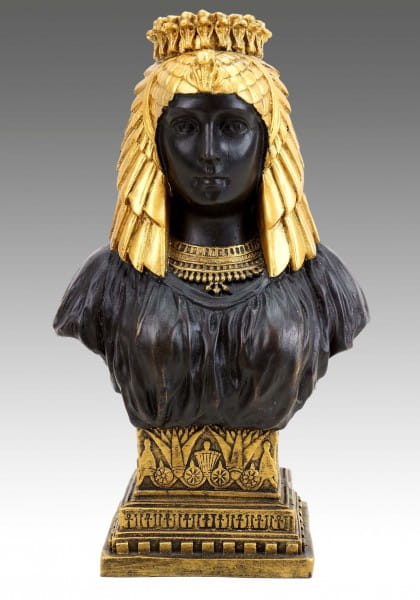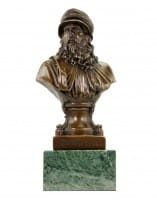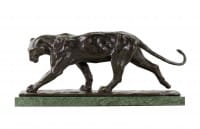€499.00 *
Prices incl. VAT, free shipping worldwide
Ready to ship today,
Delivery time appr. 3-6 workdays










Egyptian Bronze Bust – Cleopatra by Milo This exquisite bronze bust, Egyptian Cleopatra... more
Product description
"Egyptian Cleopatra Bronze Bust - Statue - signed Milo"
| Weight | 1,6 kg |
Egyptian Bronze Bust – Cleopatra by Milo
This exquisite bronze bust, Egyptian Cleopatra by the artist Milo, embodies the beauty, power, and mystery of Cleopatra VII, the last queen of Egypt’s Ptolemaic dynasty. Renowned for her intelligence, charm, and political acumen, Cleopatra has inspired artists and storytellers for centuries. In this bronze sculpture, Milo captures Cleopatra’s enigmatic allure, blending classical Egyptian motifs with a modern artistic approach. This bust is a homage to the queen’s legacy and the fascination with ancient Egypt that continues to captivate the world.
Cleopatra: The Queen of the Nile
Cleopatra VII (69–30 BC) was a ruler, diplomat, and symbol of Egyptian sovereignty in an era when Egypt faced the expanding power of Rome. Known for her relationships with Julius Caesar and Mark Antony, Cleopatra skillfully wielded her charm and intellect to protect Egypt’s independence and her dynasty’s rule. Cleopatra’s persona has been romanticized throughout history, representing not only beauty but also resilience, leadership, and a deep connection to her culture.
The allure of Cleopatra lies in her ability to transcend the limitations of her time, asserting her power in a male-dominated world. This bust by Milo captures her legacy, portraying Cleopatra not only as a beautiful woman but as a commanding figure who holds her place among history’s most influential leaders.
Artistic Composition and Symbolism
Milo’s Egyptian Cleopatra bust is an artistic interpretation that embodies the queen’s grace and strength. The bust portrays Cleopatra with a serene yet powerful expression, capturing her regal poise. She is adorned in a traditional Egyptian headdress and collar, elements symbolizing royalty, divinity, and her connection to the gods. The artist’s attention to detail brings out the texture of her attire, adding depth and character to the piece.
The headdress, reminiscent of ancient Egyptian iconography, is decorated with stylized feathers and intricate patterns that enhance the exotic beauty of Cleopatra’s image. This feature is symbolic of her status and divinity, as ancient Egyptian rulers were often associated with gods and portrayed with divine attributes. Cleopatra’s eyes are sculpted with an intense gaze, suggesting intelligence and determination, a reflection of her skill as a strategist and her role as a queen who fought for her people.
The combination of the traditional Egyptian elements with Milo’s modern artistic style adds a contemporary dimension to Cleopatra’s portrayal, making her a timeless icon. This artistic fusion highlights the queen’s enduring relevance and appeal, bridging ancient Egypt’s past with the present.
Bronze Craftsmanship and Patina
Milo’s Cleopatra bust is cast in bronze, a medium renowned for its durability and classic beauty. The bronze has a rich patina that accentuates the sculpted details, from the folds of Cleopatra’s headdress to the intricate designs of her collar. The dark, earthy tones of the bronze give the bust a timeless quality, enhancing its presence as both an art piece and a cultural homage.
The patina highlights Cleopatra’s facial features, creating subtle contrasts that draw attention to her serene expression and regal posture. This finish also adds an antique quality to the piece, evoking the ancient Egyptian artifacts and sculptures that have survived millennia. The craftsmanship in the bronze allows the viewer to appreciate Milo’s skill in combining texture, light, and shadow to bring Cleopatra’s likeness to life.
The Base and Egyptian Revival Influence
The bust is mounted on a decorative base inspired by Egyptian Revival motifs, featuring patterns that echo the aesthetics of ancient Egyptian art. Egyptian Revival style, which rose to prominence in the 19th and early 20th centuries, was characterized by its use of Egyptian symbols, geometric designs, and architectural elements. This movement was influenced by archaeological discoveries in Egypt, particularly the opening of King Tutankhamun’s tomb in 1922, which sparked global interest in Egypt’s cultural heritage.
The base serves not only as a support for the sculpture but as an extension of its historical theme. It complements the bust’s regal design, anchoring it in the grandeur and mystique of ancient Egypt. This stylistic choice emphasizes the timeless appeal of Egyptian art and Cleopatra’s unique place within it, enhancing the bust’s overall presence and cultural significance.
Milo’s Artistic Legacy and Egyptian Symbolism
Milo is known for his ability to breathe new life into historical and mythological subjects, making them relevant to contemporary audiences. His Egyptian Cleopatra bust is a prime example of his skill in blending classical inspiration with modern aesthetics, creating a piece that is both historically evocative and visually compelling. The sculpture reflects Milo’s understanding of Cleopatra’s symbolic power and his respect for the artistry of ancient Egyptian civilization.
Cleopatra, as depicted in this bust, stands as a symbol of female power, independence, and allure. She represents the intersection of beauty and intellect, an image that has inspired countless artists, from ancient Roman sculptors to Renaissance painters and modern filmmakers. Milo’s interpretation honors Cleopatra’s legacy, presenting her as a figure who transcends time and culture.
A Stunning Addition for Collectors of Egyptian and Classical Art
This Egyptian Cleopatra bust by Milo is an exceptional piece for collectors of Egyptian Revival art, classical themes, or those who appreciate the beauty of historical figures interpreted through modern sculpture. It combines intricate craftsmanship with profound symbolism, making it a powerful decorative piece that commands attention.
Whether displayed in a home, gallery, or office, this bust serves as both a tribute to Cleopatra’s enduring legacy and an example of fine artistry. It invites viewers to explore the mysteries of ancient Egypt and to appreciate the timeless qualities of strength, intelligence, and elegance that Cleopatra embodies. This sculpture is more than an art piece; it is a celebration of history, beauty, and the cultural richness of ancient Egypt.
With its exquisite detailing, symbolic resonance, and elegant presentation, Milo’s Egyptian Cleopatra bust is a statement of sophistication and cultural appreciation. It stands as a reminder of Cleopatra’s influence and the fascination with Egyptian heritage that continues to inspire and intrigue, making it a valuable addition to any collection of fine art.
This exquisite bronze bust, Egyptian Cleopatra by the artist Milo, embodies the beauty, power, and mystery of Cleopatra VII, the last queen of Egypt’s Ptolemaic dynasty. Renowned for her intelligence, charm, and political acumen, Cleopatra has inspired artists and storytellers for centuries. In this bronze sculpture, Milo captures Cleopatra’s enigmatic allure, blending classical Egyptian motifs with a modern artistic approach. This bust is a homage to the queen’s legacy and the fascination with ancient Egypt that continues to captivate the world.
Cleopatra: The Queen of the Nile
Cleopatra VII (69–30 BC) was a ruler, diplomat, and symbol of Egyptian sovereignty in an era when Egypt faced the expanding power of Rome. Known for her relationships with Julius Caesar and Mark Antony, Cleopatra skillfully wielded her charm and intellect to protect Egypt’s independence and her dynasty’s rule. Cleopatra’s persona has been romanticized throughout history, representing not only beauty but also resilience, leadership, and a deep connection to her culture.
The allure of Cleopatra lies in her ability to transcend the limitations of her time, asserting her power in a male-dominated world. This bust by Milo captures her legacy, portraying Cleopatra not only as a beautiful woman but as a commanding figure who holds her place among history’s most influential leaders.
Artistic Composition and Symbolism
Milo’s Egyptian Cleopatra bust is an artistic interpretation that embodies the queen’s grace and strength. The bust portrays Cleopatra with a serene yet powerful expression, capturing her regal poise. She is adorned in a traditional Egyptian headdress and collar, elements symbolizing royalty, divinity, and her connection to the gods. The artist’s attention to detail brings out the texture of her attire, adding depth and character to the piece.
The headdress, reminiscent of ancient Egyptian iconography, is decorated with stylized feathers and intricate patterns that enhance the exotic beauty of Cleopatra’s image. This feature is symbolic of her status and divinity, as ancient Egyptian rulers were often associated with gods and portrayed with divine attributes. Cleopatra’s eyes are sculpted with an intense gaze, suggesting intelligence and determination, a reflection of her skill as a strategist and her role as a queen who fought for her people.
The combination of the traditional Egyptian elements with Milo’s modern artistic style adds a contemporary dimension to Cleopatra’s portrayal, making her a timeless icon. This artistic fusion highlights the queen’s enduring relevance and appeal, bridging ancient Egypt’s past with the present.
Bronze Craftsmanship and Patina
Milo’s Cleopatra bust is cast in bronze, a medium renowned for its durability and classic beauty. The bronze has a rich patina that accentuates the sculpted details, from the folds of Cleopatra’s headdress to the intricate designs of her collar. The dark, earthy tones of the bronze give the bust a timeless quality, enhancing its presence as both an art piece and a cultural homage.
The patina highlights Cleopatra’s facial features, creating subtle contrasts that draw attention to her serene expression and regal posture. This finish also adds an antique quality to the piece, evoking the ancient Egyptian artifacts and sculptures that have survived millennia. The craftsmanship in the bronze allows the viewer to appreciate Milo’s skill in combining texture, light, and shadow to bring Cleopatra’s likeness to life.
The Base and Egyptian Revival Influence
The bust is mounted on a decorative base inspired by Egyptian Revival motifs, featuring patterns that echo the aesthetics of ancient Egyptian art. Egyptian Revival style, which rose to prominence in the 19th and early 20th centuries, was characterized by its use of Egyptian symbols, geometric designs, and architectural elements. This movement was influenced by archaeological discoveries in Egypt, particularly the opening of King Tutankhamun’s tomb in 1922, which sparked global interest in Egypt’s cultural heritage.
The base serves not only as a support for the sculpture but as an extension of its historical theme. It complements the bust’s regal design, anchoring it in the grandeur and mystique of ancient Egypt. This stylistic choice emphasizes the timeless appeal of Egyptian art and Cleopatra’s unique place within it, enhancing the bust’s overall presence and cultural significance.
Milo’s Artistic Legacy and Egyptian Symbolism
Milo is known for his ability to breathe new life into historical and mythological subjects, making them relevant to contemporary audiences. His Egyptian Cleopatra bust is a prime example of his skill in blending classical inspiration with modern aesthetics, creating a piece that is both historically evocative and visually compelling. The sculpture reflects Milo’s understanding of Cleopatra’s symbolic power and his respect for the artistry of ancient Egyptian civilization.
Cleopatra, as depicted in this bust, stands as a symbol of female power, independence, and allure. She represents the intersection of beauty and intellect, an image that has inspired countless artists, from ancient Roman sculptors to Renaissance painters and modern filmmakers. Milo’s interpretation honors Cleopatra’s legacy, presenting her as a figure who transcends time and culture.
A Stunning Addition for Collectors of Egyptian and Classical Art
This Egyptian Cleopatra bust by Milo is an exceptional piece for collectors of Egyptian Revival art, classical themes, or those who appreciate the beauty of historical figures interpreted through modern sculpture. It combines intricate craftsmanship with profound symbolism, making it a powerful decorative piece that commands attention.
Whether displayed in a home, gallery, or office, this bust serves as both a tribute to Cleopatra’s enduring legacy and an example of fine artistry. It invites viewers to explore the mysteries of ancient Egypt and to appreciate the timeless qualities of strength, intelligence, and elegance that Cleopatra embodies. This sculpture is more than an art piece; it is a celebration of history, beauty, and the cultural richness of ancient Egypt.
With its exquisite detailing, symbolic resonance, and elegant presentation, Milo’s Egyptian Cleopatra bust is a statement of sophistication and cultural appreciation. It stands as a reminder of Cleopatra’s influence and the fascination with Egyptian heritage that continues to inspire and intrigue, making it a valuable addition to any collection of fine art.
Height: 20.0 cm
Width: 13.0 cm
Depth: 7.0 cm
Weight: 1.6 kg
Related links to "Egyptian Cleopatra Bronze Bust - Statue - signed Milo"
Read, write and discuss reviews... more
Customer evaluation for "Egyptian Cleopatra Bronze Bust - Statue - signed Milo"
Write an evaluation
Evaluations will be activated after verification.
Our advantages
free shipping
Worldwide free shipping
14 days money back
You can cancel your order
within 14 days
secure payment services
Paypal, Master Card, Visa, American Express and more




























































